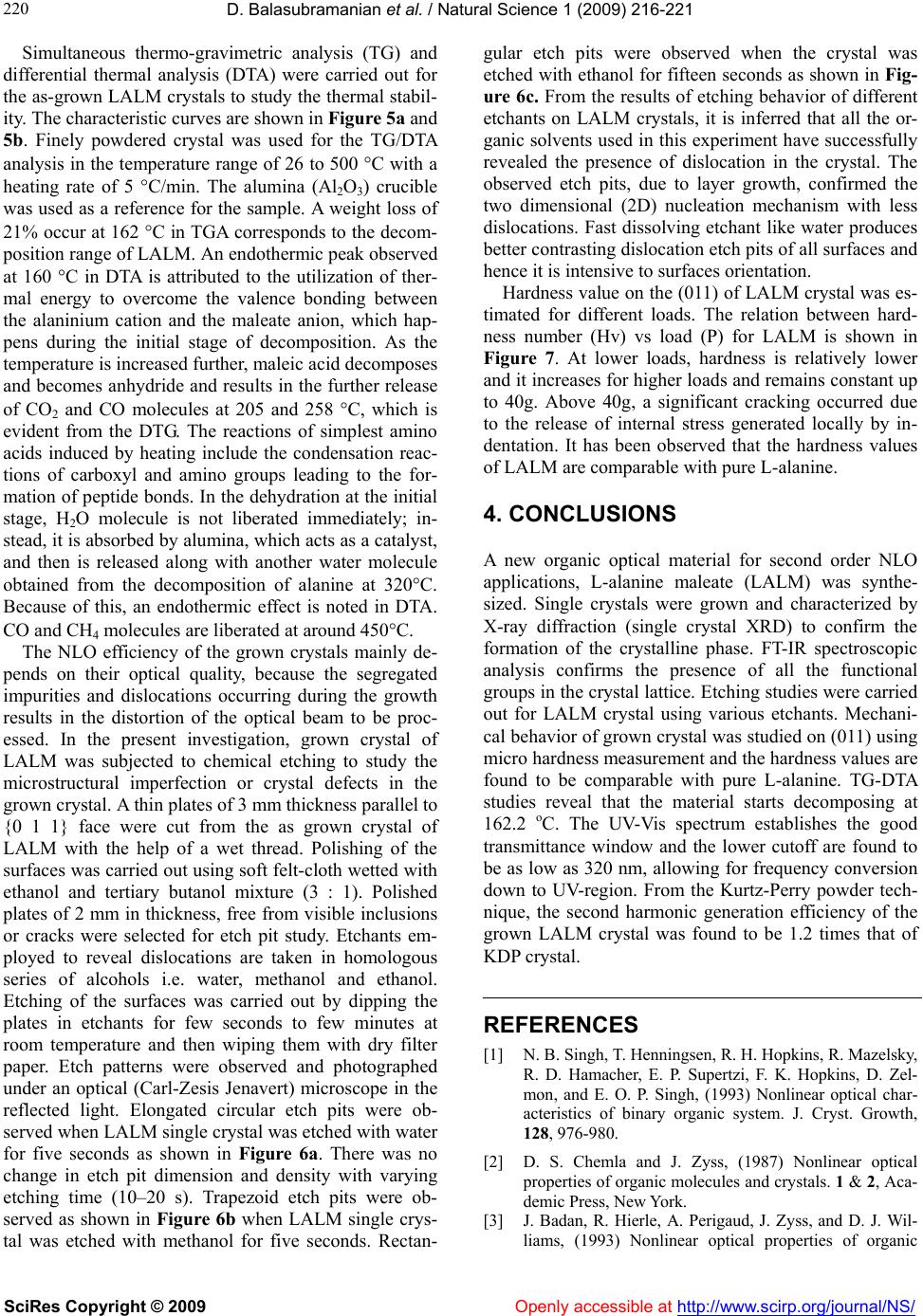
D. Balasubramanian et al. / Natural Science 1 (2009) 216-221
SciRes Copyright © 2009 Openly accessible at http://www.scirp.org/journal/NS/
220
Simultaneous thermo-gravimetric analysis (TG) and
differential thermal analysis (DTA) were carried out for
the as-grown LALM crystals to study the thermal stabil-
ity. The characteristic curves are shown in Figure 5a and
5b. Finely powdered crystal was used for the TG/DTA
analysis in the temperature range of 26 to 500 C with a
heating rate of 5 C/min. The alumina (Al2O3) crucible
was used as a reference for the sample. A weight loss of
21% occur at 162 C in TGA corresponds to the decom-
position range of LALM. An endothermic peak observed
at 160 C in DTA is attributed to the utilization of ther-
mal energy to overcome the valence bonding between
the alaninium cation and the maleate anion, which hap-
pens during the initial stage of decomposition. As the
temperature is increased further, maleic acid decomposes
and becomes anhydride and results in the further release
of CO2 and CO molecules at 205 and 258 C, which is
evident from the DTG. The reactions of simplest amino
acids induced by heating include the condensation reac-
tions of carboxyl and amino groups leading to the for-
mation of peptide bonds. In the dehydration at the initial
stage, H2O molecule is not liberated immediately; in-
stead, it is absorbed by alumina, which acts as a catalyst,
and then is released along with another water molecule
obtained from the decomposition of alanine at 320C.
Because of this, an endothermic effect is noted in DTA.
CO and CH4 molecules are liberated at around 450C.
The NLO efficiency of the grown crystals mainly de-
pends on their optical quality, because the segregated
impurities and dislocations occurring during the growth
results in the distortion of the optical beam to be proc-
essed. In the present investigation, grown crystal of
LALM was subjected to chemical etching to study the
microstructural imperfection or crystal defects in the
grown crystal. A thin plates of 3 mm thickness parallel to
{0 1 1} face were cut from the as grown crystal of
LALM with the help of a wet thread. Polishing of the
surfaces was carried out using soft felt-cloth wetted with
ethanol and tertiary butanol mixture (3 : 1). Polished
plates of 2 mm in thickness, free from visible inclusions
or cracks were selected for etch pit study. Etchants em-
ployed to reveal dislocations are taken in homologous
series of alcohols i.e. water, methanol and ethanol.
Etching of the surfaces was carried out by dipping the
plates in etchants for few seconds to few minutes at
room temperature and then wiping them with dry filter
paper. Etch patterns were observed and photographed
under an optical (Carl-Zesis Jenavert) microscope in the
reflected light. Elongated circular etch pits were ob-
served when LALM single crystal was etched with water
for five seconds as shown in Figure 6a. There was no
change in etch pit dimension and density with varying
etching time (10–20 s). Trapezoid etch pits were ob-
served as shown in Figure 6b when LALM single crys-
tal was etched with methanol for five seconds. Rectan-
gular etch pits were observed when the crystal was
etched with ethanol for fifteen seconds as shown in Fig-
ure 6c. From the results of etching behavior of different
etchants on LALM crystals, it is inferred that all the or-
ganic solvents used in this experiment have successfully
revealed the presence of dislocation in the crystal. The
observed etch pits, due to layer growth, confirmed the
two dimensional (2D) nucleation mechanism with less
dislocations. Fast dissolving etchant like water produces
better contrasting dislocation etch pits of all surfaces and
hence it is intensive to surfaces orientation.
Hardness value on the (011) of LALM crystal was es-
timated for different loads. The relation between hard-
ness number (Hv) vs load (P) for LALM is shown in
Figure 7. At lower loads, hardness is relatively lower
and it increases for higher loads and remains constant up
to 40g. Above 40g, a significant cracking occurred due
to the release of internal stress generated locally by in-
dentation. It has been observed that the hardness values
of LALM are comparable with pure L-alanine.
4. CONCLUSIONS
A new organic optical material for second order NLO
applications, L-alanine maleate (LALM) was synthe-
sized. Single crystals were grown and characterized by
X-ray diffraction (single crystal XRD) to confirm the
formation of the crystalline phase. FT-IR spectroscopic
analysis confirms the presence of all the functional
groups in the crystal lattice. Etching studies were carried
out for LALM crystal using various etchants. Mechani-
cal behavior of grown crystal was studied on (011) using
micro hardness measurement and the hardness values are
found to be comparable with pure L-alanine. TG-DTA
studies reveal that the material starts decomposing at
162.2 oC. The UV-Vis spectrum establishes the good
transmittance window and the lower cutoff are found to
be as low as 320 nm, allowing for frequency conversion
down to UV-region. From the Kurtz-Perry powder tech-
nique, the second harmonic generation efficiency of the
grown LALM crystal was found to be 1.2 times that of
KDP crystal.
REFERENCES
[1] N. B. Singh, T. Henningsen, R. H. Hopkins, R. Mazelsky,
R. D. Hamacher, E. P. Supertzi, F. K. Hopkins, D. Zel-
mon, and E. O. P. Singh, (1993) Nonlinear optical char-
acteristics of binary organic system. J. Cryst. Growth,
128, 976-980.
[2] D. S. Chemla and J. Zyss, (1987) Nonlinear optical
properties of organic molecules and crystals. 1 & 2, Aca-
demic Press, New York.
[3] J. Badan, R. Hierle, A. Perigaud, J. Zyss, and D. J. Wil-
liams, (1993) Nonlinear optical properties of organic